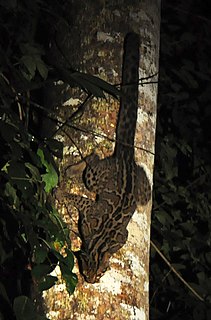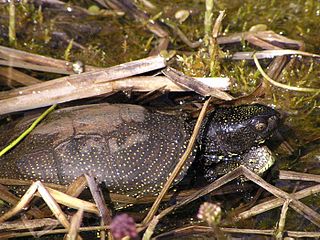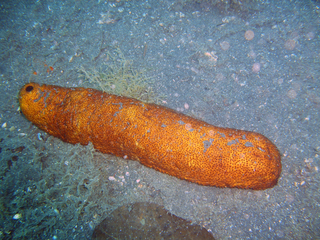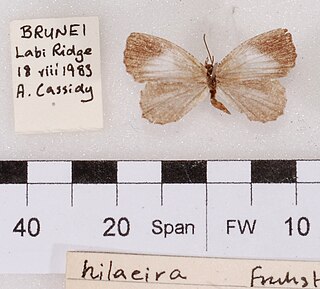Marmorata can refer to several different species or conditions presenting with a marbled appearance, including:

The marbled cat is a small wild cat native from the eastern Himalayas to Southeast Asia, where it inhabits forests up to 2,500 m (8,200 ft) altitude. As it is present in a large range, it has been listed as Near Threatened on the IUCN Red List since 2015.

Emys is a small genus of turtles in the family Emydidae. The genus is endemic to Europe and North America.

The western pond turtle, also known commonly as the Pacific pond turtle is a species of small to medium-sized turtle in the family Emydidae. The species is endemic to the western coast of the United States and Mexico, ranging from western Washington state to northern Baja California. It was formerly found in Canada, but in May 2002, the Canadian Species at Risk Act listed the Pacific pond turtle as being extirpated.

Cutis marmorata telangiectatica congenita is a rare congenital vascular disorder that usually manifests in affecting the blood vessels of the skin. The condition was first recognised and described in 1922 by Cato van Lohuizen, a Dutch pediatrician whose name was later adopted in the other common name used to describe the condition – Van Lohuizen Syndrome. CMTC is also used synonymously with congenital generalized phlebectasia, nevus vascularis reticularis, congenital phlebectasia, livedo telangiectatica, congenital livedo reticularis and Van Lohuizen syndrome.

The giant mottled eel, also known as the marbled eel, is a species of tropical anguillid eel that is found in the Indo-Pacific and adjacent freshwater habitats.
The elm cultivar Ulmus 'Marmorata' was identified by Dieck, Zöschen, Germany in Haupt-catalog der Obst- und gehölzbaumschulen des ritterguts Zöschen bei Merseburg 1885 as Ulmus campestris marmorata. Considered "probably U. carpinifolia" by Green.

Scaphiophryne marmorata is a species of frog in the family Microhylidae. It is commonly known as the green burrowing frog and the marbled rain frog. It is endemic to Madagascar. It is classified as "Vulnerable" by the IUCN as it is threatened by habitat loss.

Nannophrys marmorata, commonly known as Kirtisinghe's rock frog or marbled streamlined frog, is a species of frog endemic to Sri Lanka. It used to be placed in the large frog family Ranidae but a phylogenetic study was undertaken using DNA sequences and it is now included in the family Dicroglossidae. Its natural habitats are tropical moist lowland forests, moist montane forests, rivers and streams. It is threatened by habitat loss.

Piramide is a station on Line B of the Rome Metro. It was opened on 10 February 1955 and is sited on Piazzale Ostiense just outside Porta San Paolo, in the Ostiense quarter. Its atrium houses mosaics that have won the Artemetro Roma by Enrico Castellani (Italy) and Beverly Pepper. The station has escalators.

Bohadschia marmorata, commonly known as the brown sandfish, is a species of sea cucumber in the family Holothuriidae. It lives on the seabed in shallow waters in the Indo-Pacific region.
Mesocolpia marmorata is a moth in the family Geometridae. It is found in Nigeria and Sierra Leone.
Ropica is a genus of beetles in the family Cerambycidae, containing the following species:
Marbled eel is a common name for several fishes; while it most commonly refers to Anguilla marmorata, it may also refer to:
Ropica biroi is a species of beetle in the family Cerambycidae. It was described by Breuning in 1953.
Ropica sechellarum is a species of beetle in the family Cerambycidae. It was described by Breuning in 1957. It contains the subspecies Ropica sechellarum interruptefasciata and Ropica sechellarum sechellarum.

Ropica honesta is a species of beetle in the family Cerambycidae. It was described by Pascoe in 1865. It is known from Borneo, Sumatra, Java, New Guinea, the Philippines, and China.
Ropica formosana is a species of beetle in the family Cerambycidae. It was described by Bates in 1866. It contains four subspecies, Ropica formosana formosana, Ropica formosana japonica, Ropica formosana nobuoi, and Ropica formosana tokaraensis.

Logania marmorata, the pale mottle, is a butterfly in the family Lycaenidae. It was described by Frederic Moore in 1884. It is found in the Indomalayan realm.

Stamnodes marmorata is a species of geometrid moth in the family Geometridae. It is found in North America.













